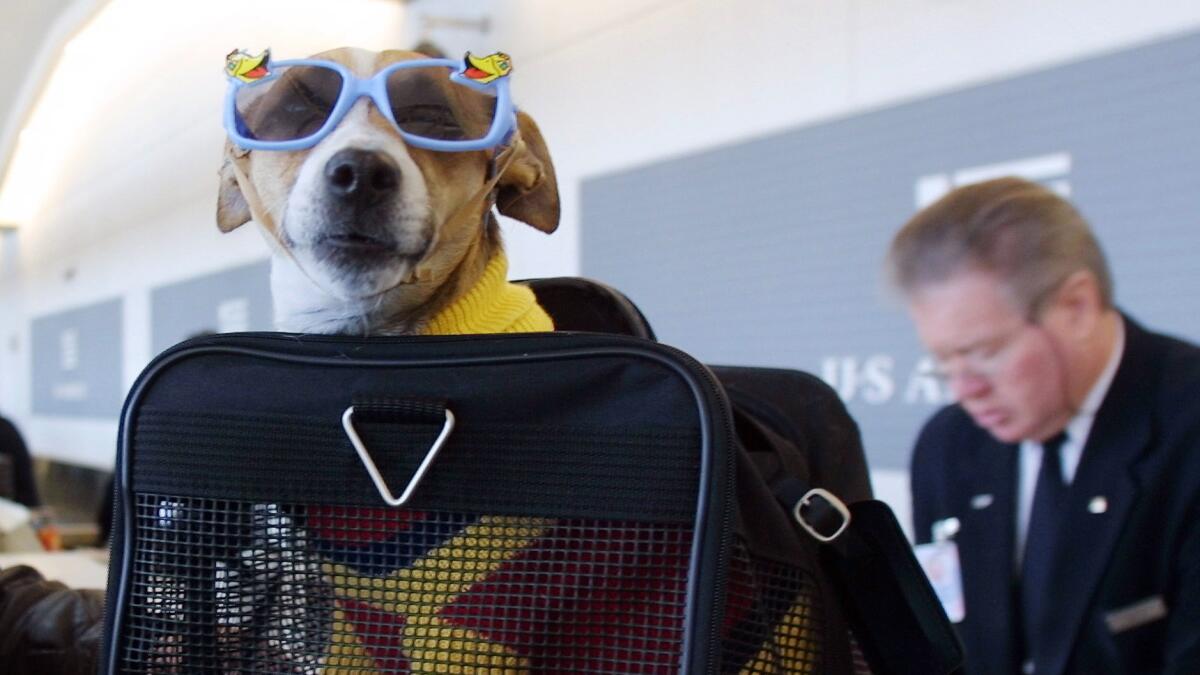Why emotional support animals have flying privileges that a mere pet does not

- Share via
As a veteran flight attendant for a large commercial airline, I admit that flying has gone to the dogs. I mean that literally.
For as long as I can remember, passengers have paid an extra fee to stow the pet Chihuahua in a kennel and bring it aboard for the ride. But these days, a flying lap dog may be classified as an emotional support animal, or ESA.
During boarding on a recent flight from Los Angeles to Miami, a woman wearing dark sunglasses and carrying a Prada bag eased into her first-class seat and promptly pressed the flight attendant call button.
“Champagne,” she said flatly, when I showed up at her seat.
I smiled at her, glanced at the Yorkshire terrier in her lap and told her the purser would serve pre-departure beverages momentarily.
Before returning to my duties in the galley, I noticed another pooch, this one a Shih Tzu. A woman in the first row of business class was peppering it with kisses.
I checked the passenger roster on my flight attendant tablet. Sure enough, the first-class passenger in seat 2-A was traveling with an emotional support animal. Apparently, she had presented the proper documentation demonstrating to the airline that she had been diagnosed with a psychological or emotional issue that allows an ESA onboard.
The business-class woman in 3-D, however, was traveling with a pet. On commercial aircraft, pets and ESAs are two distinctly different animals.
Pets must remain in a kennel and stowed beneath a seat during all stages of a flight. Emotional support animals have no such restriction. They may rest in the owner’s lap, sit at the owner’s feet and go wherever the owner goes — including the lavatory.
Another difference is that pet owners must pay a fee to fly with a furry friend ($125 each way on American, United and Delta; $95 on Southwest; $100 on JetBlue). Emotional support animals travel free.
The Air Carrier Access Act of 1986 prohibits air carriers from discriminating on the basis of physical or mental disability. Airlines are required to allow service animals to accompany passengers with disabilities.
According to airline regulations, service animals “may include dogs, cats, monkeys, seizure alert animals or other animals that assist the customer with physical/emotional/psychiatric/medical support.”
Herein lies the argument.
Many pet owners would feel happier, more secure and — dare I say it? — more emotionally at ease if they could cuddle a pet for the duration of a flight.
This was the logic the woman in 3-D tried to use when she was told to keep her Shih Tzu in the kennel beneath her seat. In her opinion, it wasn’t fair that the first-class passenger was allowed to hold her dog, when she, a business-class traveler, could not.
The crew explained the difference between pets and service animals, but the woman in 3-D could not be consoled. For six long hours her Shih Tzu remained caged in its soft-sided prison. For six long hours she glared while the woman in 2-A cradled her Yorkie as if it were a newborn child.
Airline policy prohibits flight attendants from inquiring about a passenger’s disability. We’re allowed to say only, “What service does your support animal provide for you?” Which is exactly what I asked the woman in 2-A shortly before landing in Miami.
She removed her sunglasses (the only time she did so during the flight) and winked at me. “She’s my baby.” That’s all she said.
Who am I to question the validity of a Yorkie’s emotional support status? The air carrier legislation does not require crew members to verify the legitimacy of an emotional support animal.
Although the airline I work for allows a maximum of 14 pets (two dogs/cats stowed in seven kennels) on wide-body aircraft, the number of service animals allowed is unlimited.
If 100 passengers show up with 100 emotional support animals on your next flight, you will be flying to your destination in your own airborne kennel.
My only question is this: Who gets to clean up after the beasts?
More to Read
Sign up for The Wild
We’ll help you find the best places to hike, bike and run, as well as the perfect silent spots for meditation and yoga.
You may occasionally receive promotional content from the Los Angeles Times.






